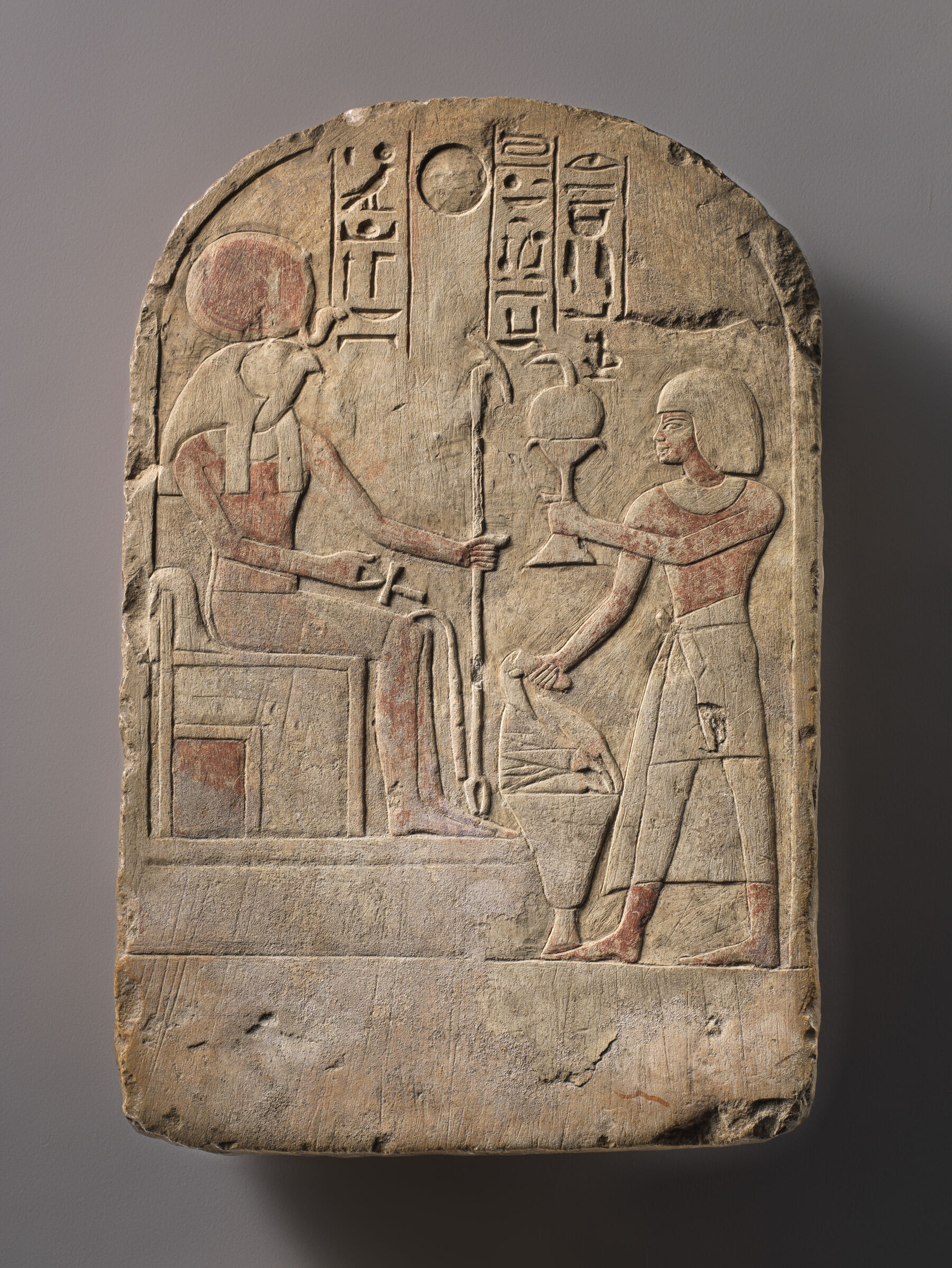The worship of the solar god Re-Horakhty grew in popularity during the reigns of Thutmose IV and Amenhotep III. Votive stelae depicting private individuals worshiping deities face-to-face also became popular. This direct access, without the king as an intermediary, is one of the indicators of personal piety in ancient Egypt.1
Re-Horakhty is seated on a raised block throne before an altar with a lotus flower. The falcon-headed god is crowned by a red sun disk encircled by a cobra. He wears a broad collar and a kilt with a lion’s tail. He holds a was-scepter in his right hand and an ankh in his left. On New Kingdom stelae, divine images were often placed under the winged sun disk.2 On this stela, the disk stands alone in the central register, perhaps carved by mistake without wings.3 Nehemya stands before the god, offering incense in his upraised hand and pouring a libation on the altar with his other. He wears a short wig, broad collar, and short kilt under a long apron. The skin color of the god and Nehemya are painted red. Re-Horakhty’s eye was indicated in pigment. The facial features of Nehemya date the stela to the reigns of Thutmose IV or early Amenhotep III.
The inscription above the god says, “Re-Horakhty, Great God, Lord of Heaven.” Above the offerer, it reads, “Offering (wdn) everything good and pure for your ka, made by Nehemya.”
MH
-
Podemann Sørensen, Jørgen. 1989. “Divine access: the so-called democratization of Egyptian funerary literature as a socio-cultural process.” In The Religion of the Ancient Egyptians: Cognitive Structures and Popular Expressions. Proceedings of Symposia in Uppsala and Bergen 1987 and 1988, edited by Gertie Englund, 109–125. Uppsala: S. Academiae Ubsaliensis.; Bickel, Susanne. 2002. “Aspects et fonctions de la déification d’Amenhotep III.” BIFAO 102: 63–90.; Hartwig, Melinda K. 2004. Tomb painting and identity in ancient Thebes, 1419-1372 BCE. Série IMAGO 2; Monumenta Aegyptiaca 10. Brussels; Turnhout: Fondation égyptologique Reine Élisabeth; Brepols.. ↩︎
-
Robins, Gay. 1997. The art of ancient Egypt. London: The British Museum Press.. ↩︎
-
See stelae without divine symbols above the god in Galán, José M. and Gema Menéndez. 2018. Catalogue general of the Egyptian Museum in Cairo. Nos. 35001-35066: Deir el-Medina stelae and other inscribed objects. Cairo: Supreme Council of Antiquities Press.; and UCL14476. ↩︎
Bibliography
- Bickel 2002
- Bickel, Susanne. 2002. “Aspects et fonctions de la déification d’Amenhotep III.” BIFAO 102: 63–90.
- Galán and Menéndez 2018
- Galán, José M. and Gema Menéndez. 2018. Catalogue general of the Egyptian Museum in Cairo. Nos. 35001-35066: Deir el-Medina stelae and other inscribed objects. Cairo: Supreme Council of Antiquities Press.
- Hartwig 2004
- Hartwig, Melinda K. 2004. Tomb painting and identity in ancient Thebes, 1419-1372 BCE. Série IMAGO 2; Monumenta Aegyptiaca 10. Brussels; Turnhout: Fondation égyptologique Reine Élisabeth; Brepols.
- Podemann Sørensen 1989
- Podemann Sørensen, Jørgen. 1989. “Divine access: the so-called democratization of Egyptian funerary literature as a socio-cultural process.” In The Religion of the Ancient Egyptians: Cognitive Structures and Popular Expressions. Proceedings of Symposia in Uppsala and Bergen 1987 and 1988, edited by Gertie Englund, 109–125. Uppsala: S. Academiae Ubsaliensis.
- Robins 1997
- Robins, Gay. 1997. The art of ancient Egypt. London: The British Museum Press.
